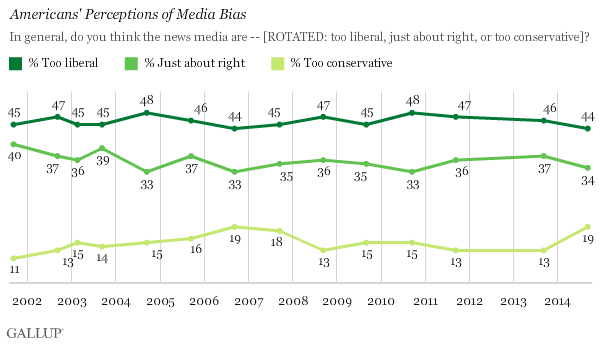Trust in Mass Media Returns to All-Time Low
6 percentage-point drops in trust among Democrats and Republicans
WASHINGTON, D.C. -- After registering slightly higher trust last year, Americans' confidence in the media's ability to report "the news fully, accurately, and fairly" has returned to its previous all-time low of 40%. Americans' trust in mass media has generally been edging downward from higher levels in the late 1990s and the early 2000s.

Prior to 2004, Americans placed more trust in mass media than they do now, with slim majorities saying they had a "great deal" or "fair amount" of trust. But over the course of former President George W. Bush's re-election season, the level of trust fell significantly, from 54% in 2003 to 44% in 2004. Although trust levels rebounded to 50% in 2005, they have failed to reach a full majority since.
Americans' trust in the media in recent years has dropped slightly in election years, including 2008, 2010, 2012, and again this year -- only to edge its way back up again in the following odd-numbered years. Although the differences between the drops and the recoveries are not large, they suggest that something about national elections triggers skepticism about the accuracy of the news media's reporting.
Among Democrats, Trust in Media at a 14-Year Low
Trust among Democrats, who have traditionally expressed much higher levels of confidence in the media than Republicans have, dropped to a 14-year low of 54% in 2014. Republicans' trust in the media is at 27%, one percentage point above their all-time low, while independents held steady at 38% -- up one point from 37% in 2013.

Sharp Uptick in Americans Who Think News Media Are "Too Conservative"
As has been the case historically, Americans are most likely to feel the news media are "too liberal" (44%) rather than "too conservative," though this perceived liberal bias is now on the lower side of the trend. One in three (34%) say the media are "just about right" in terms of their coverage -- down slightly from 37% last year.
Nearly one in five Americans (19%) say the media are too conservative, which is still relatively low, but the highest such percentage since 2006. This is up six points from 2013 -- the sharpest increase in the percentage of Americans who feel the news skews too far right since Gallup began asking the question in 2001.

Conservatives (70%) are far more likely than liberals (15%) to perceive the media as too liberal. Moderates' views are closer to liberals, with 35% calling the media too liberal. Likewise, relatively few moderates -- similar to conservatives -- think the media are too conservative.
Democrats -- with a small majority of 52% -- are most likely to think the media are just about right, while a mere 18% of Republicans feel this way about the news. More than seven in 10 Republicans say the media are too liberal.

Bottom Line
Though a sizable percentage of Americans continue to have a great deal or fair amount of trust in the media, Americans' overall trust in the Fourth Estate continues to be significantly lower now than it was 10 to 15 years ago.
As the media expand into new domains of news reporting via social media networks and new mobile technology, Americans may be growing disenchanted with what they consider "mainstream" news as they seek out their own personal veins of getting information. At the same time, confidence is down across many institutions, and a general lack in trust overall could be at play.
Americans' opinions about the media appear affected in election years, however. Americans' trust in the media will likely recover slightly in 2015 with the absence of political campaigns. But the overarching pattern of the past decade has shown few signs of slowing the decline of faith in mass media as a whole.
Results for this Gallup poll are based on telephone interviews conducted Sept. 4-7, 2014, with a random sample of 1,017 adults, aged 18 and older, living in all 50 U.S. states and the District of Columbia.
For results based on the total sample of national adults, the margin of sampling error is ±4 percentage points at the 95% confidence level.
Interviews are conducted with respondents on landline telephones and cellular phones, with interviews conducted in Spanish for respondents who are primarily Spanish-speaking. Each sample of national adults includes a minimum quota of 50% cellphone respondents and 50% landline respondents, with additional minimum quotas by time zone within region. Landline and cellular telephone numbers are selected using random-digit-dial methods. Landline respondents are chosen at random within each household on the basis of which member had the most recent birthday.
Samples are weighted to correct for unequal selection probability, nonresponse, and double coverage of landline and cell users in the two sampling frames. They are also weighted to match the national demographics of gender, age, race, Hispanic ethnicity, education, region, population density, and phone status (cellphone only/landline only/both, and cellphone mostly). Demographic weighting targets are based on the most recent Current Population Survey figures for the aged 18 and older U.S. population. Phone status targets are based on the most recent National Health Interview Survey. Population density targets are based on the most recent U.S. census. All reported margins of sampling error include the computed design effects for weighting.
In addition to sampling error, question wording and practical difficulties in conducting surveys can introduce error or bias into the findings of public opinion polls.
View survey methodology, complete question responses, and trends.
For more details on Gallup's polling methodology, visit www.gallup.com.




Replies
I'm glad to hear it.
Great news. :)
Mainstream Media/Goebbel's Wet Dream - get the word out!
LOL, and crying at the same time. The truth hurts, doesn't it?